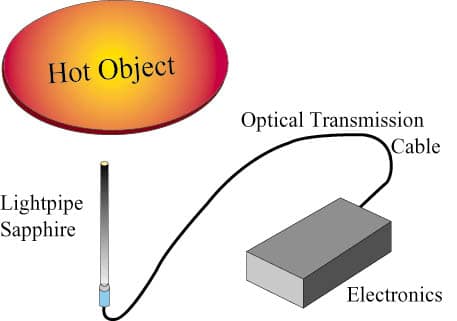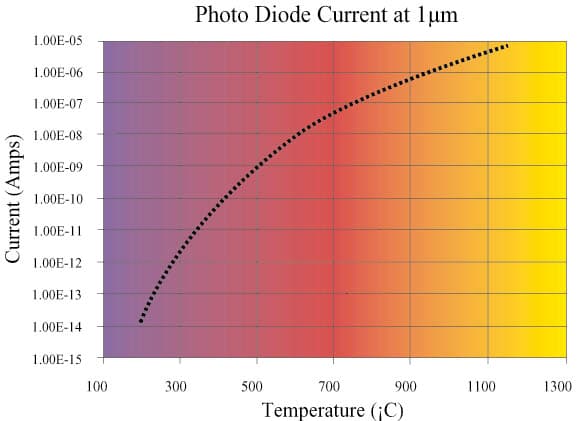Introduction
Fiber optic temperature measurement has been in use for decades1.The most prevalent methods are fluorescent and radiation thermometry, also knownas pyrometry. Fluorescent temperature measurement is used for lower-rangemeasurements from -200°C to +450°C. Pyrometry best covers ranges from100°C to 4,000°C, and is based on the physics of Planck’s blackbodyradiation equation2.
As higher quality in products and tighter process control become critical,so does the production use of sapphire fiber optic temperature measurement. Thein-situ use of sapphire lightpipes to collect hot-object-emission isbecoming the industry standard for many industrial processes. Companies such asEaton, DuPont, Corning Glass, Lucent Technologies, IBM, and Intel all use thistechnology. Equipment companies and furnace vendors are implementing lightpipesand fiber optic temperature measurement systems in semiconductor, glass,aerospace, and materials processes. Fiber optics afford greater designflexibility, and provide the capability to create a virtual blackbodyenvironment. They also have several advantages over thermocouples: low noise,about 1000 times better; high resolution, 0.01°C; high speed and fastresponse, enabling up to 20,000 measurements per second; and non-contactoperation – a must for the semiconductor industry.
Basics of Fiber Optic Pyrometry
Fiber optic radiation thermometry is composed of the collection optics(sapphire lightpipes or lens), optical transmission cable, optical-to-electricalconversion (photodetector), and signal processing (Fig. 1). Generally, thecollection optics is a rod or flexible fiber of sapphire directed at the hotobject. The lightpipe is placed so as to create increased emissivity, such as asmall hole through a holder or by placing a mirror close to the hot object1,3,4,5.Sometimes a lens assembly is used instead of the sapphire and the optical signalis taken to the electronics through optical transmission cable.
Typical fiber optic system for temperaturemeasurement.
Small and Large Signals
A typical output from a photodetector can change nine orders of magnitude(1,000,000,000 times) over an input range from 200°C to 1200°C. InFigure 2, the steepness of the curve at low temperatures should be noted,showing a large change in current for a small change in temperature. This meansthat the available signal is dropping off very quickly at these lowertemperatures. This is often referred to as a _cliff._ The way the photodiodeoutput is handled determines the temperature range and system performance.Historically, the _best_ signal amplification has been a trans-impedanceamplifier6. This amplifier approach has a lower temperature limitdefined by Shot and Johnson noise. Shot noise arises from the statisticalfluctuation in the current; Johnson noise originates mainly from the amplifier’sfeedback resistor.
Another approach uses an integrating amplifier. The feedback resistor can beconsidered as being replaced by the equivalent of an integrating capacitor.There are two basic advantages to the integrating amplifier approach: there isno longer the electrical noise associated with the feedback resistor on thefirst stage gain, and the integrating amplifier measures photons for a longertime period (integrates) and is more sensitive to low light levels. The lowesttemperature capable of being measured at 1-µm wavelengths, using thetrans-impedance amplifier, is about 300°C, with 1°C resolution. Acooled integrating amplifier can measure to about 200°C using 1-µmwavelength light.
Photodiode current at 1µm wavelength
Measurement Problems
Unknown emissivity is always the most serious problem with any pyrometrictemperature measurement. It can cause very large errors (see table). Generally,errors are always larger for longer wavelengths and higher temperatures. Thereis a myth in pyrometry, that by using two wavelengths the emissivity problem issolved. Although it is true that if emissivity is the same at both wavelengthsor changes by the same rate, the ratio of intensities will yield temperaturefrom the Planck equation. However, emissivity rarely changes the same at bothwavelengths as a part is heated or processed.
| Pyrometric Measurement Error Associated with an EmissivityError of 0.2 (0.7 to 0.9) | ||
| Object Temperature | Wavelength | Error |
| 500°C | 1µm | 10°C |
| 3µm | 27°C | |
| 1000°C | 1µm | 27°C |
| 3µm | 73°C | |
Real-life emissivities range from 0.1 (aluminum) to over 0.95 (graphite) andeverything in-between1,3. Emissivity is also dependent on surfacefilms and the angle of emission. Unless a pseudo or virtual blackbody is formed- or the Ripple technique employed – the error can be large.
Ripple Technique
The use of the time-dependent component of background light to determinereal time emissivity was first presented as the “ripple technique”7,8. It takes advantage of the fluctuating nature of a backgroundlight source to determine the amount of light reflected off any hot sample. The60-Hz AC line frequency of lights can be used as the fluctuating backgroundlight. The reflectivity of any sample is the ratio of the incoming AC light tothe reflection of that AC light signal off the hot sample. Given the view angleof the lightpipe the emissivity is one minus reflectivity or:
Emissivity = 1 – IS/
IB
where IB isthe AC component of the background light, and
IS is thebackground light’s AC component reflected from the hot sample.
Conclusions
Temperature measurement using optical fibers and wavelengths under 1µm,continues gaining widespread acceptance. The shorter wavelength gives a smalleremissivity error. For optimum measurement and control the combination of thesapphire fiber, low noise circuitry, and the ripple technique yield the bestnon-contact temperature measurements. Currently the best multi-point temperaturemeasurement system measures from 100°C to 2000°, with a resolution of0.01°C at 80Hz, using short wavelength light.
The use of sapphire lightpipes will continue gaining acceptance for alltypes of applications in industry and science. At least a dozen equipmentmanufacturers now use lightpipes for in-situ temperature measurements,and more than 10,000 optical fiber-based temperature systems have been sold.
References:
1. D.P. DeWitt, Theory and Practice of RadiationThermometry, edited by D.P. DeWitt and G.D. Nutter, Wiley, New York, (1988).
2. M. Planck, Annals of Physics, 4 (3), 553, (1901)
3. C. Schietinger, Chapter 3 and 4 in Advances in Rapid Thermal andIntegrated Processing, edited by F. Roozeboom, Kluwer Academic Publishers,Dordrecht, The Netherlands, 1996.
4. Christian M. Gronet and Gary E. Miner, European Patent ApplicationPublication No. 612 862, (24 Jan. 1994).
5. P. Vandenabeele and K. Maex, J. Vac. Sci. Technol. B, 9, 2784-2787(1991).
6. C. Schietinger, E. Jensen, Mater. Res. Soc. Symp. Proc. Spring MeetingSan Francisco 1996.
7. C. Schietinger, B. Adams and C. Yarling, Mater. Res. Soc. Symp. Proc.224, (1991) pp. 23-31.
8. C. Schietinger and B. Adams, U.S. Patents 5,154,512 (13 Oct. 1992),5,166,080 (24 Nov. 1992), 5,310,260 (10 May 1994), 5,318,362 (7 June 1994),5,490,728 (13 Feb. 1996).












